Discover the Philippines: Your Ultimate Guide to Must-Visit Natural Wonders and Historic Landmarks
The Philippines, an archipelago nation in Southeast Asia, is a treasure trove of breathtaking natural beauty and deeply rooted historical significance. From majestic volcanoes and ancient churches to pristine beaches and vibrant marine ecosystems, these landmarks vividly showcase the country’s rich culture, diverse heritage, and stunning landscapes. Whether you’re an avid traveler planning your next adventure, a history enthusiast eager to delve into the past, or simply curious about the wonders this nation holds, this comprehensive guide is crafted just for you.
Prepare to embark on a virtual journey through a curated list of must-see landmarks that encapsulate the very best of what the Philippines has to offer. We’ll explore not just their beauty, but also their unique stories, cultural importance, and practical tips for visitors. From the awe-inspiring natural formations that have stood for millennia to the iconic cultural spots that tell tales of resilience and faith, this guide will illuminate why each of these places holds a special place in the heart of the Philippines and its visitors. Are you ready to uncover the magic and marvels of these truly amazing landmarks?
Top Landmarks in the Philippines
1. Rizal Park (Luneta Park)

Located in the heart of Manila, Rizal Park, also known as Luneta Park, stands as a solemn tribute to the Philippines’ national hero, Dr. Jose Rizal. This expansive urban park is more than just a green oasis; it’s a historical site featuring iconic monuments, meticulously maintained gardens, and adjacent museums that collectively narrate the compelling story of Philippine history and its struggle for independence. The Rizal Monument, guarded by soldiers, marks the spot where Dr. Rizal was executed, serving as a powerful symbol of national pride and sacrifice. Visitors can explore the various themed gardens, enjoy the musical dancing fountain, or simply relax amidst the bustling city. It’s a place where history meets leisure, offering both educational insights and recreational opportunities.
- Best Times to Visit: For the most pleasant experience, visit early in the morning or late afternoon. The cooler weather makes it ideal for leisurely strolls, and you can witness the changing of the guard ceremony at the monument.
- Visiting Hours: The park grounds are generally open daily from 5:00 AM to 9:00 PM, with specific museum and garden attractions having their own schedules within these hours.
2. Intramuros: The Walled City
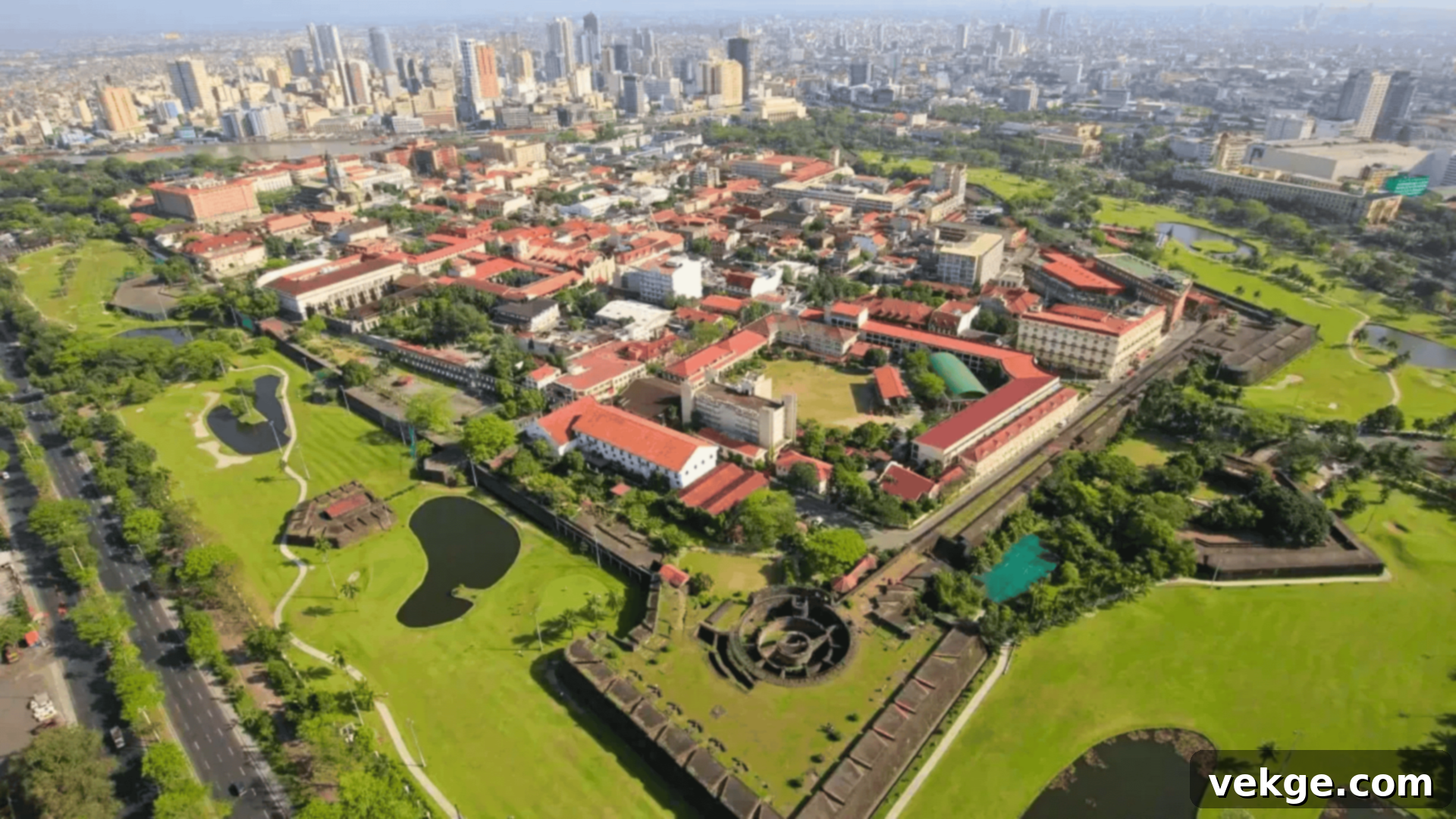
Step back in time as you enter Intramuros, Manila’s historic walled city. This incredibly preserved district is a living testament to the country’s colonial past under Spanish rule, filled with magnificent Spanish-era buildings, ancient churches, and insightful museums. Walking along its cobblestone streets, you’ll encounter iconic sites like San Agustin Church (a UNESCO World Heritage site), Casa Manila, and Fort Santiago. Visitors can explore the area on foot, by bamboo bike (bambike), or kalesa (horse-drawn carriage), immersing themselves in the atmosphere of a bygone era. Intramuros isn’t just a collection of old structures; it’s a powerful symbol of the Philippines’ enduring cultural heritage and its journey through centuries of influence and change.
- Best Times to Visit: The cooler months, typically from October to April, offer the most comfortable weather for exploring Intramuros and its outdoor attractions.
- Visiting Hours: Intramuros is open to the public every day, though specific attractions like museums and churches usually operate from 8:00 AM to 6:00 PM.
3. Chocolate Hills, Bohol
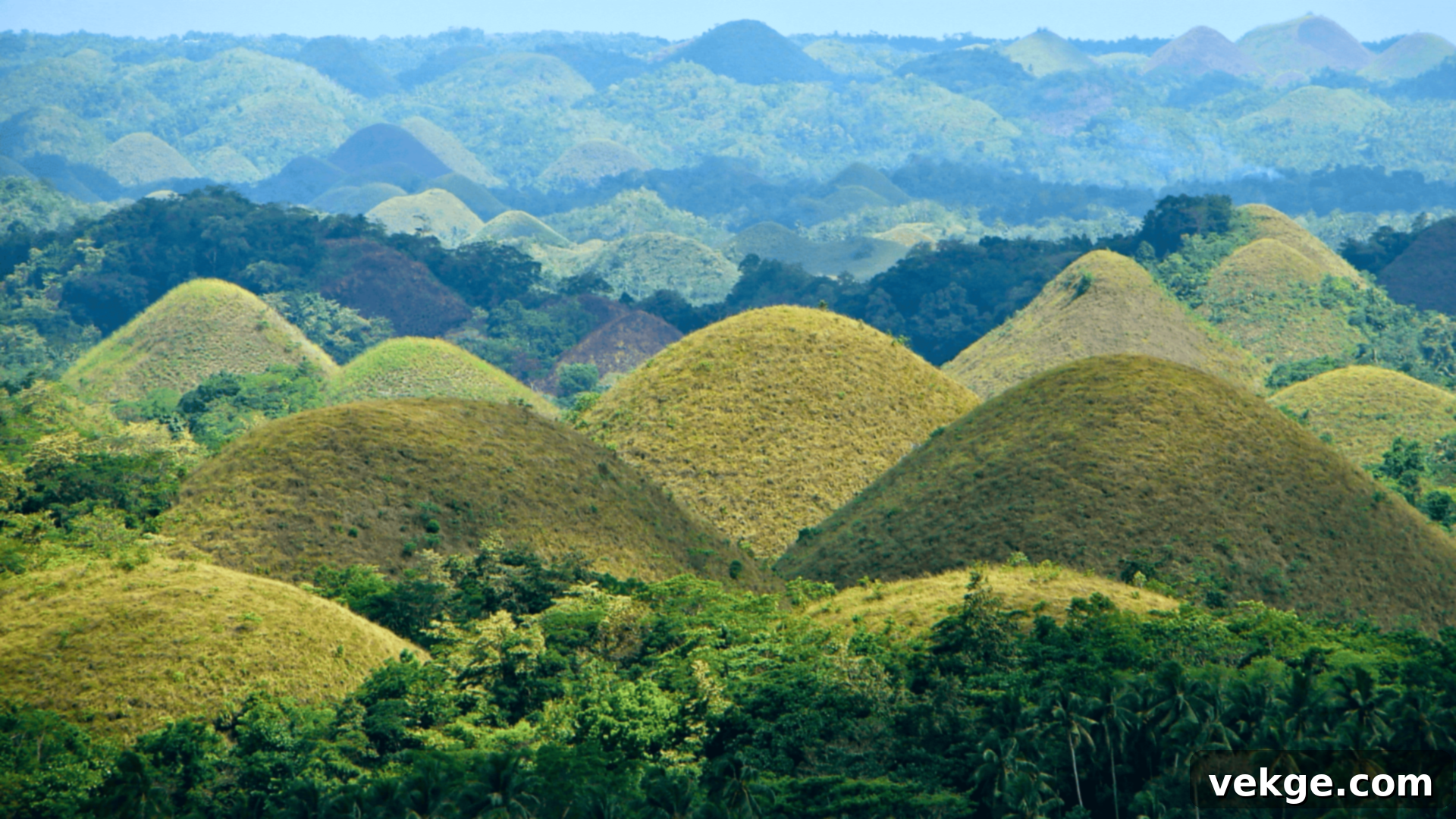
A truly unique natural formation, the Chocolate Hills are the most famous attraction in Bohol. This geological wonder is comprised of over 1,268 perfectly cone-shaped hills spread across an area of more than 50 square kilometers. During the dry season, the green grass covering these hills turns a rich chocolatey brown, giving them their distinctive name and resemblance to giant chocolate mounds. The sight from the viewing deck is nothing short of mesmerizing, offering panoramic vistas of this extraordinary landscape. The Chocolate Hills are not only a sight to behold but also a subject of local legends, adding to their mystical allure. It’s a natural masterpiece that captivates every visitor.
- Best Times to Visit: To witness the hills in their iconic brown hue, plan your trip during the dry season, from March to May.
- Visiting Hours: The main viewing complex is typically open daily from 8:00 AM to 6:00 PM.
4. Taal Volcano, Batangas
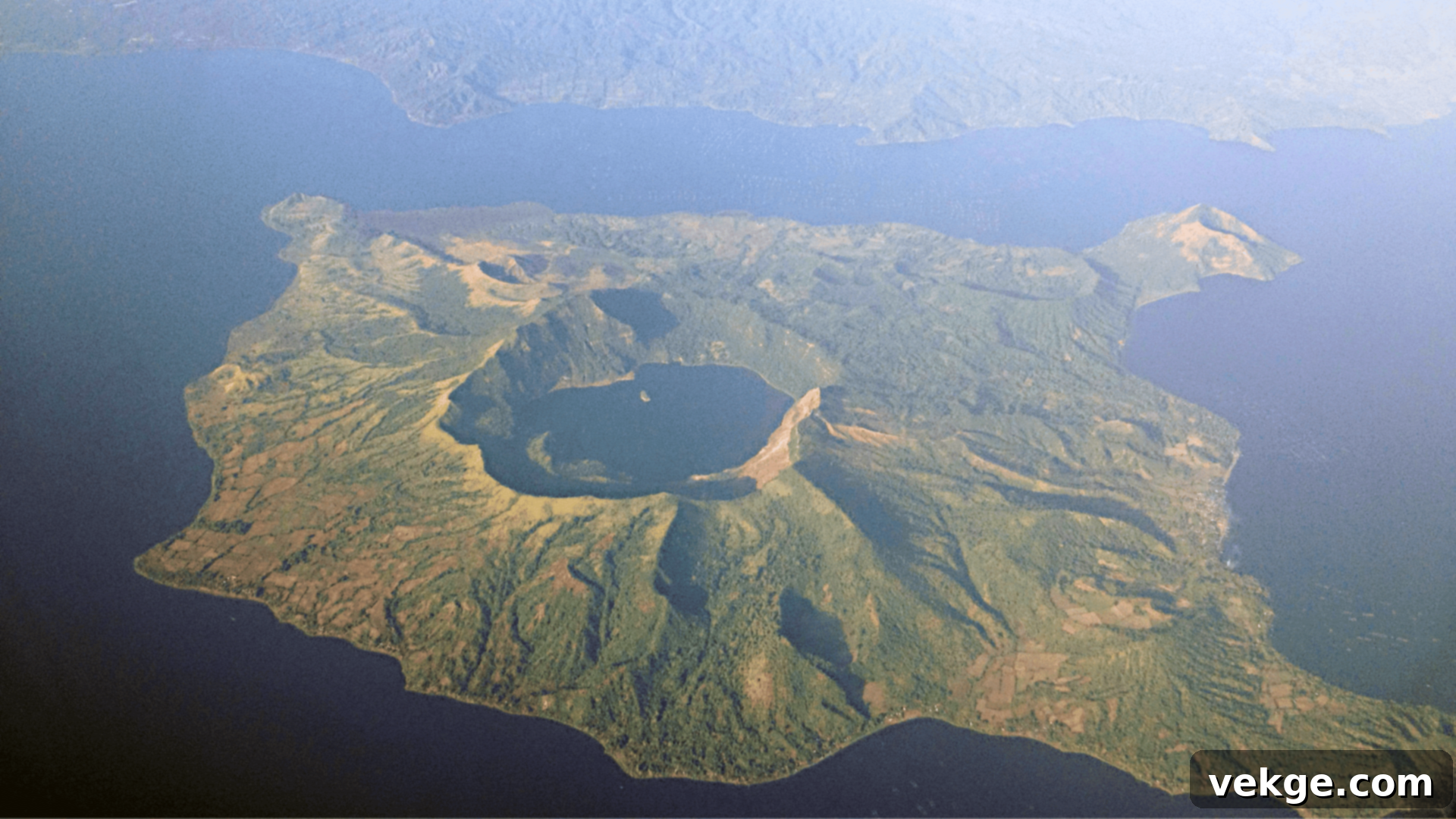
Often described as a “volcano within a lake, within a volcano, within a lake,” Taal Volcano in Batangas is one of the most active and picturesque volcanoes in the Philippines. It dramatically sits as an island within Taal Lake, offering truly stunning views that are a photographer’s dream. While its activity requires careful monitoring and safety precautions, visitors can often still enjoy the incredible panoramas from vantage points around the lake, such as Tagaytay. For adventurers, hiking opportunities to get closer to the main crater (when safe) offer a thrilling experience and even more breathtaking vistas. The unique geographical setting makes Taal Volcano a truly unforgettable natural landmark.
- Best Times to Visit: The cooler months from December to February are ideal for visiting the Taal Lake area, avoiding the intense heat and ensuring clearer views.
- Visiting Hours: Access to viewing areas and guided tours typically run from 7:00 AM to 4:00 PM, subject to volcanic activity and safety advisories.
5. Banaue Rice Terraces, Ifugao
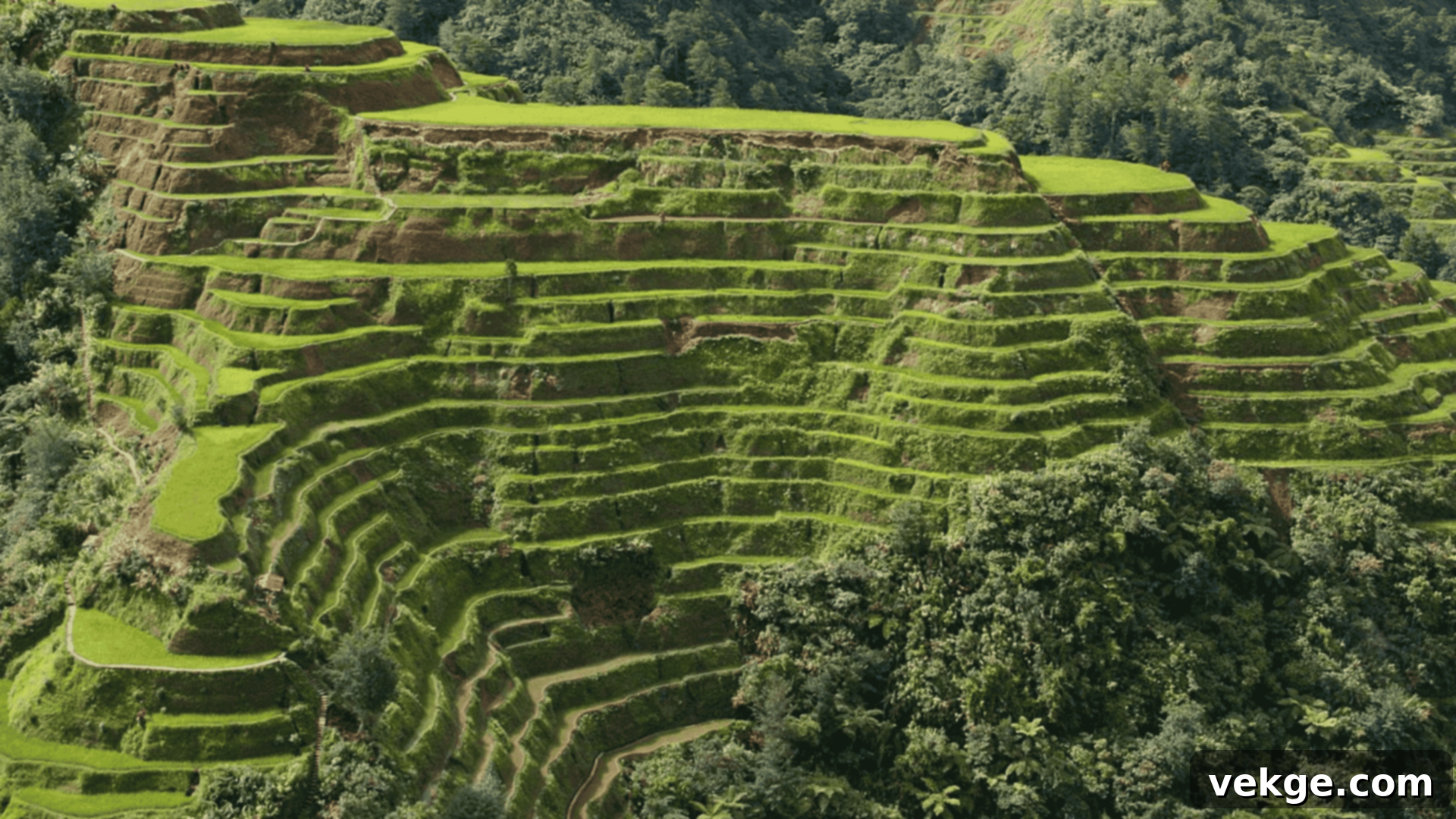
Often hailed as the “Eighth Wonder of the World,” the Banaue Rice Terraces are an astonishing testament to indigenous engineering and community resilience. Carved into the towering mountains of Ifugao by ancestors of the indigenous people more than 2,000 years ago, these intricate rice paddies resemble giant steps reaching up to the sky. They are a UNESCO World Heritage site, not just for their physical grandeur but also for representing a harmonious relationship between man and nature. The terraces are still actively used to plant rice and vegetables, maintaining a living cultural landscape. Visiting Banaue offers a deep dive into the rich culture of the Ifugao people and presents unparalleled opportunities for trekking and cultural immersion.
- Best Times to Visit: The best time to visit is during the planting season (April to May) when the terraces are vibrant green, or during harvest season (June to July) for a golden landscape. December to February also offers cool, dry weather for comfortable exploration.
- Visiting Hours: The terraces are viewable year-round, with the best photography and trekking opportunities during daylight hours.
6. Fort Santiago, Intramuros
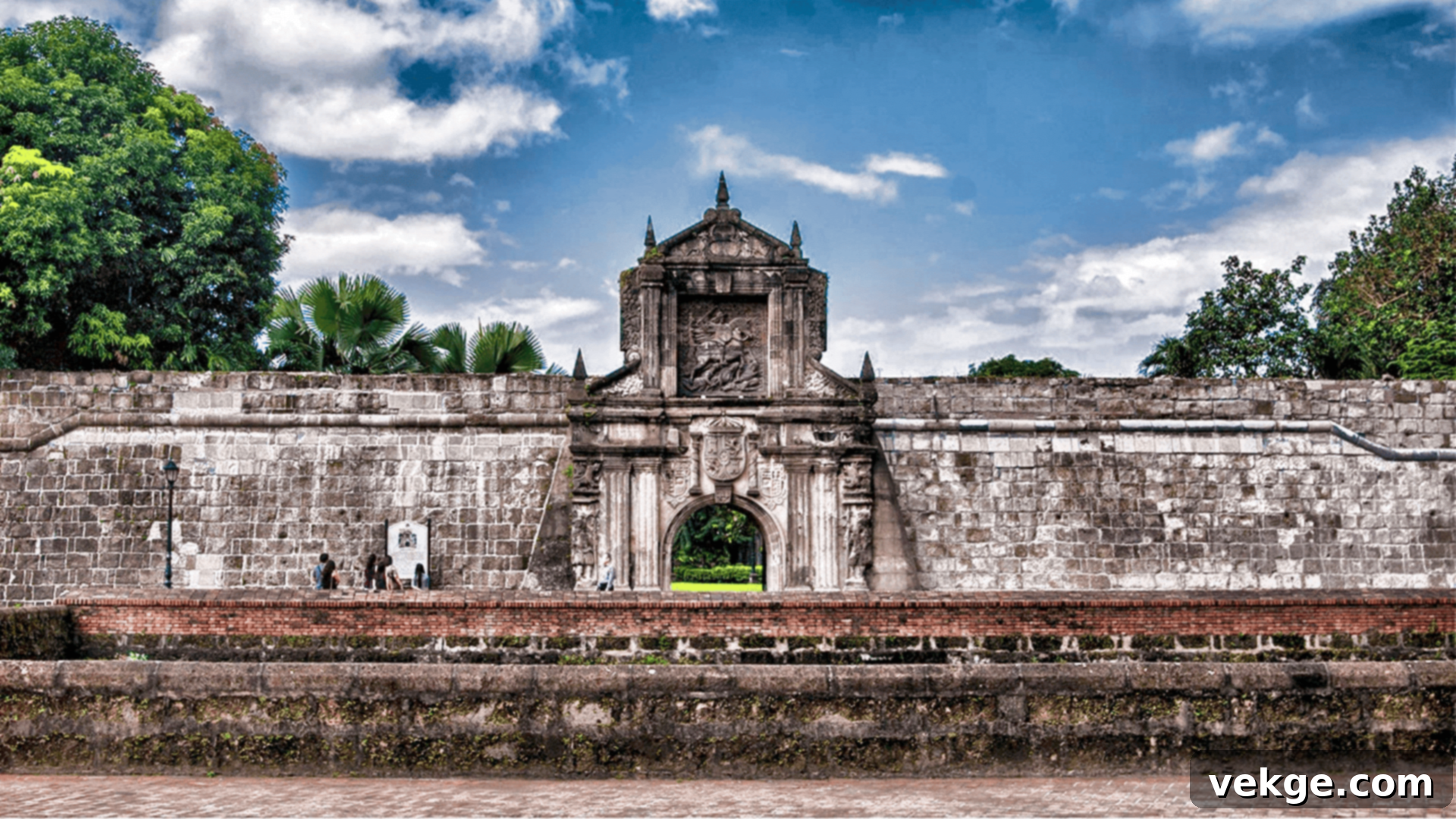
Within the historic walls of Intramuros lies Fort Santiago, a citadel that played a pivotal role in Philippine history. This ancient stone fortress, built by the Spanish conquistador Miguel López de Legazpi, served as a defense structure and prison for many Filipino patriots, including Dr. Jose Rizal, who spent his last days here before his execution. Visitors can walk through its well-preserved gates, explore the dungeons, and learn about the harrowing events that unfolded within its walls through informative markers and displays. The beautiful Rizal Shrine museum inside the fort offers a poignant look into the national hero’s life and works. Fort Santiago stands as a powerful symbol of Filipino bravery and sacrifice during centuries of foreign occupation.
- Best Times to Visit: Similar to Intramuros, the cooler months from October to April provide the most comfortable weather for exploring the fort’s grounds.
- Visiting Hours: The fort is generally open daily from 8:00 AM to 6:00 PM.
7. Mayon Volcano, Albay

Mayon Volcano, situated in the province of Albay, is globally renowned for its almost perfect cone shape, often considered one of the most symmetrical volcanoes in the world. This active stratovolcano is not just a geological marvel but also a stunning sight that dominates the landscape, exuding both beauty and immense power. Its elegant silhouette has inspired countless artworks and is a source of immense pride for the Bicol region. While always active and carefully monitored, visitors can enjoy spectacular views from various lookout points, such as the Cagsawa Ruins, which provide a dramatic foreground to Mayon’s grandeur. Adventure seekers can also embark on ATV rides around its base, offering a unique way to experience its imposing presence.
- Best Times to Visit: The dry season, from March to May, offers the clearest skies and optimal visibility for viewing Mayon’s perfect cone.
- Visiting Hours: The volcano itself is accessible year-round from various viewpoints, with the best visiting hours for scenic viewing typically from 7:00 AM to 5:00 PM.
8. Paoay Church (San Agustin Church), Ilocos Norte
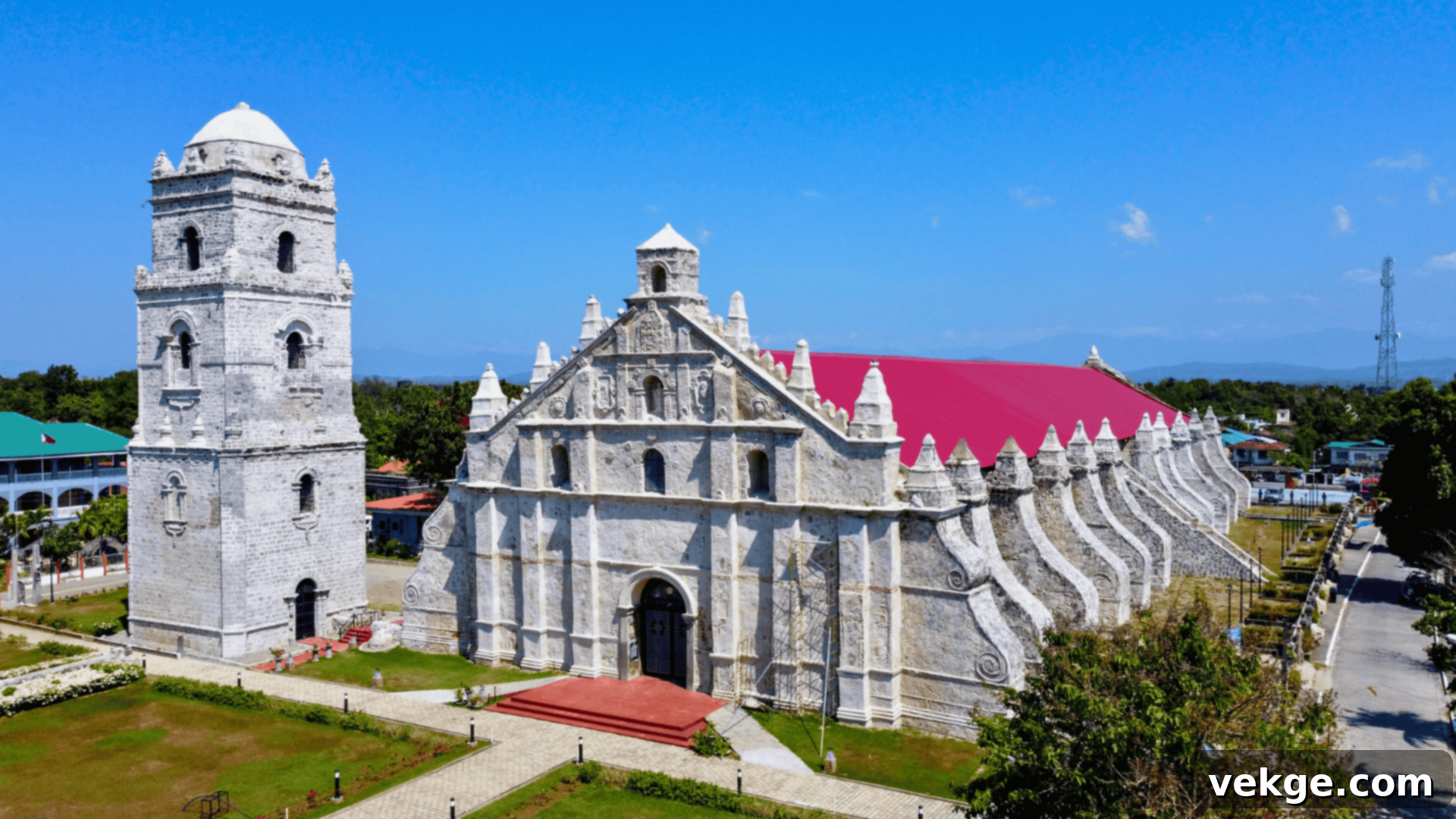
Officially known as San Agustin Church of Paoay, Paoay Church in Ilocos Norte is a magnificent UNESCO World Heritage site and one of the oldest and most architecturally significant churches in the Philippines. It is celebrated for its distinct ‘earthquake baroque’ architectural style, characterized by massive coral stone buttresses on the sides and back, designed to protect the structure from seismic activity. This unique design is a blend of baroque, Gothic, and Chinese influences, reflecting a truly indigenous interpretation of European church architecture. The church’s grandeur and resilience make it a compelling landmark, drawing visitors to admire its historical depth and artistic mastery. It stands as a powerful symbol of faith and architectural ingenuity in the country.
- Best Times to Visit: The dry season, from November to May, offers the most pleasant weather for exploring the church and its surroundings.
- Visiting Hours: The church is generally open daily for visitors from 8:00 AM to 5:00 PM.
9. Palawan Underground River (Puerto Princesa Subterranean River National Park)

A true natural wonder, the Puerto Princesa Subterranean River National Park, famously known as the Palawan Underground River, is a UNESCO World Heritage site and one of the New7Wonders of Nature. Located in Puerto Princesa, Palawan, it features one of the longest navigable underground rivers in the world, flowing directly into the sea. Visitors take a small boat ride deep into the cave, marveling at the spectacular stalactite and stalagmite formations, vast chambers, and unique ecosystems within. The surrounding national park also boasts a lush forest, home to diverse wildlife. This captivating destination offers an unparalleled experience of geological marvels and biodiversity, making it an essential visit for any nature lover.
- Best Times to Visit: The dry season, from December to April, offers the calmest seas and most pleasant weather for the boat trip to the cave entrance and the underground river tour.
- Visiting Hours: The park is open daily from 8:00 AM to 4:00 PM, with tours often requiring pre-booking due to popularity and limited entry.
10. Corregidor Island
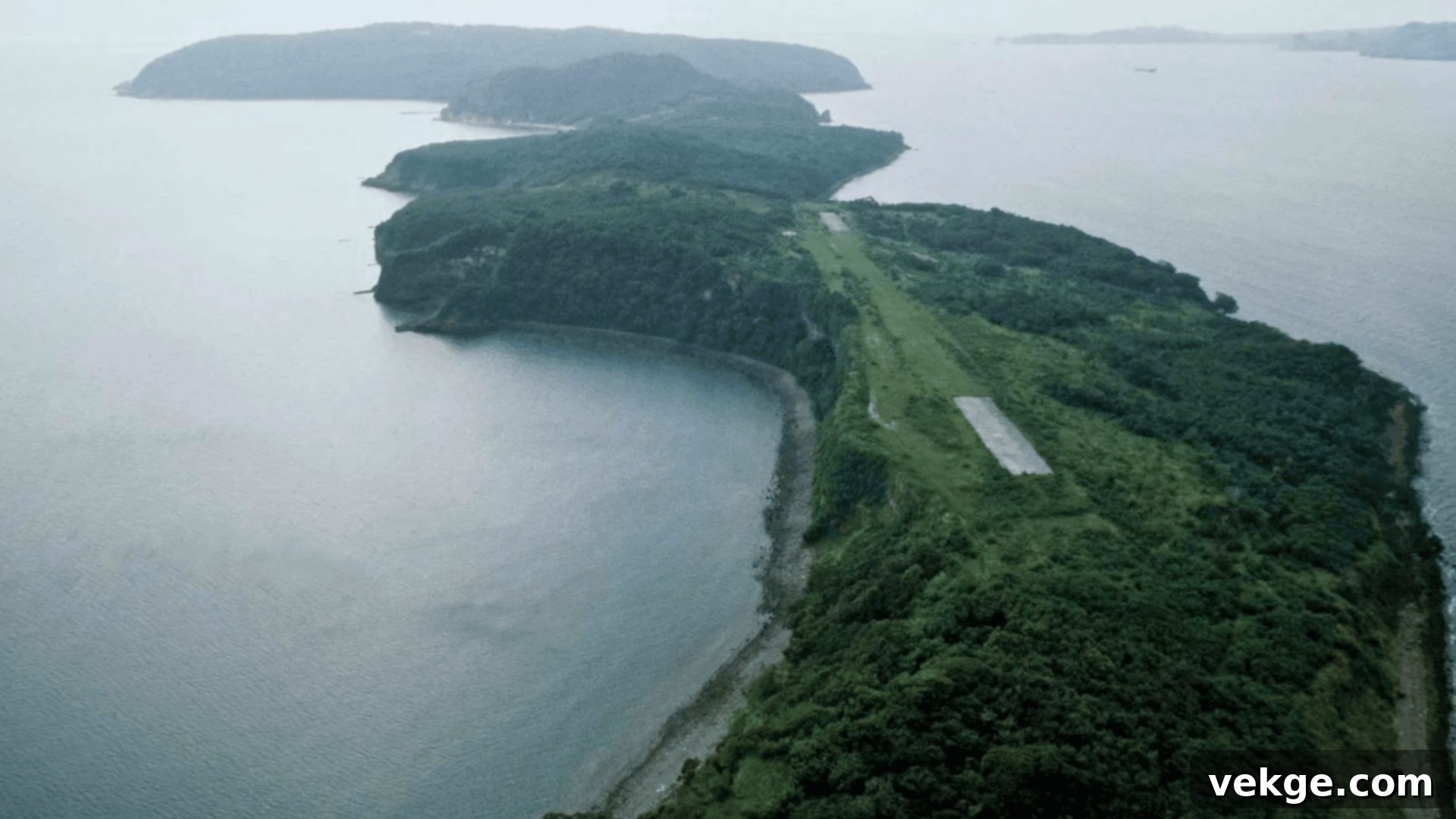
Situated at the entrance of Manila Bay, Corregidor Island is a profoundly significant historical landmark, particularly for its role during World War II. This small, tadpole-shaped island served as a crucial defense fortress for the Philippines and the United States, witnessing some of the most intense battles and heroic stands against invading forces. Today, it stands as a solemn memorial and a powerful reminder of courage and sacrifice. Visitors can explore the ruins of barracks, batteries, and the famous Malinta Tunnel through guided tours, gaining deep insights into its military history and the lives of those who defended it. A trip to Corregidor is a moving experience, offering a tangible connection to a pivotal period in global history.
- Best Times to Visit: The cooler months, from November to February, are the most comfortable for exploring the island’s outdoor historical sites, avoiding the intense heat of summer.
- Visiting Hours: The island is primarily visited via organized day tours, which typically operate from 8:00 AM to 5:00 PM, including ferry travel to and from Manila.
11. Manila Cathedral (Minor Basilica and Metropolitan Cathedral of the Immaculate Conception)
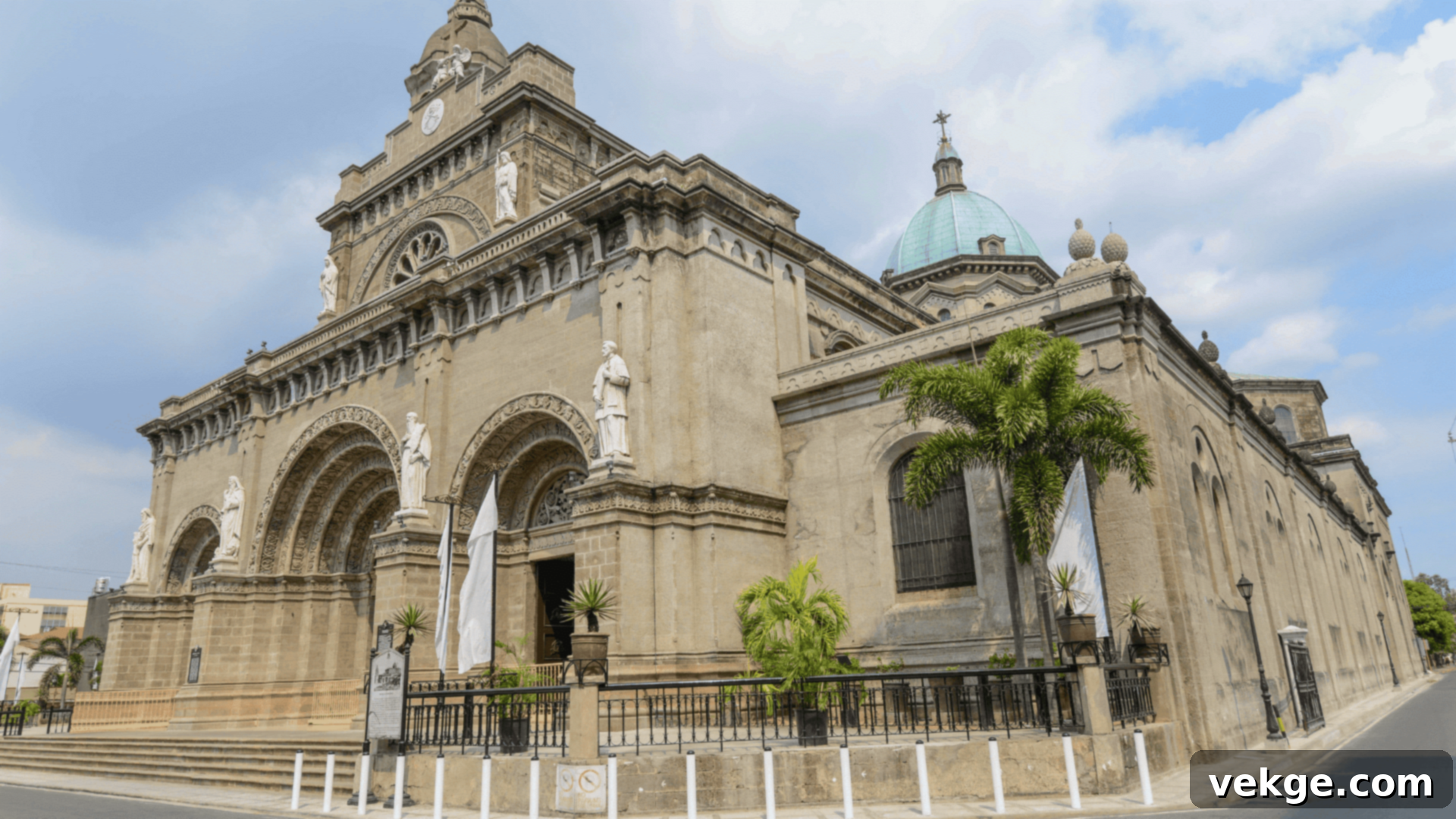
The Manila Cathedral, officially known as the Minor Basilica and Metropolitan Cathedral of the Immaculate Conception, is one of the oldest and most beautiful churches in the Philippines. Located prominently within the historic walls of Intramuros, it has been rebuilt several times throughout its long history, surviving earthquakes, fires, and wars, each time rising grander than before. Its current magnificent Romanesque-Byzantine architecture and intricate stained-glass windows make it a stunning example of religious artistry. Beyond its architectural splendor, the Manila Cathedral continues to stand as a powerful symbol of faith, resilience, and the enduring spiritual heart of the Filipino people, playing a central role in Catholic life in the country.
- Best Times to Visit: Visiting during the cooler months, from October to February, offers comfortable sightseeing inside and around the cathedral.
- Visiting Hours: The cathedral is generally open daily from 8:00 AM to 5:00 PM, though hours may vary for masses and special events.
12. Vigan Historic City, Ilocos Sur
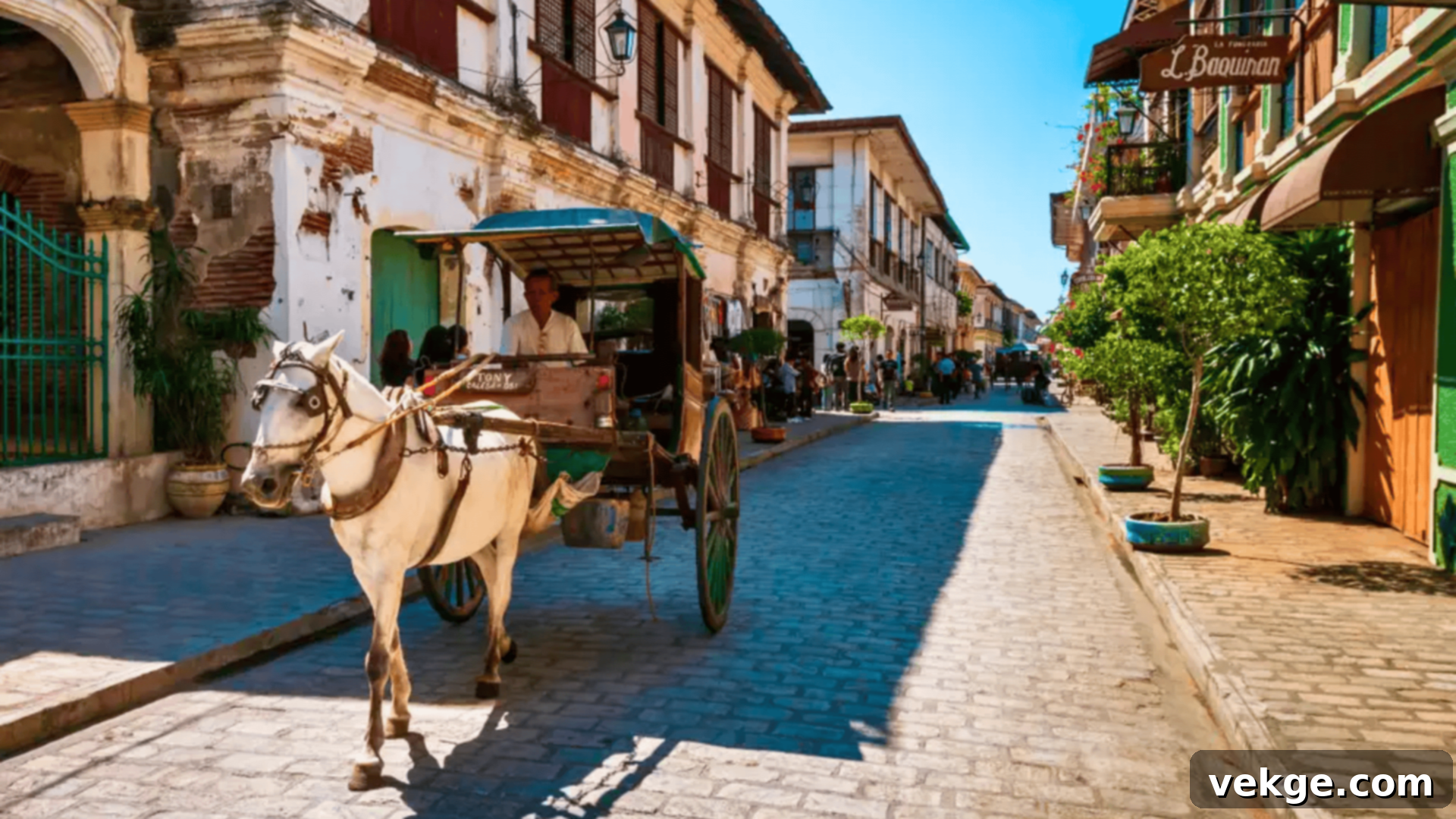
Vigan, located in Ilocos Sur, is a truly remarkable UNESCO World Heritage site and one of the best-preserved examples of a planned Spanish colonial town in Asia. Its cobblestone streets, grand ancestral houses with their distinctive ‘bahay na bato’ architecture, and charming kalesa rides transport visitors back to the Spanish colonial era. Calle Crisologo, the city’s most famous street, is pedestrian-only at certain times, allowing for an immersive experience amidst its heritage buildings, antique shops, and local eateries. Vigan offers a fascinating glimpse into the Philippines’ colonial past and the cultural fusion that shaped its identity, making it an indispensable destination for history buffs and culture seekers.
- Best Times to Visit: The dry season, from November to April, provides the best weather for exploring Vigan’s streets and enjoying outdoor activities.
- Visiting Hours: The city is open year-round, with most heritage attractions and shops typically open from 8:00 AM to 6:00 PM.
13. Taal Heritage Town, Batangas
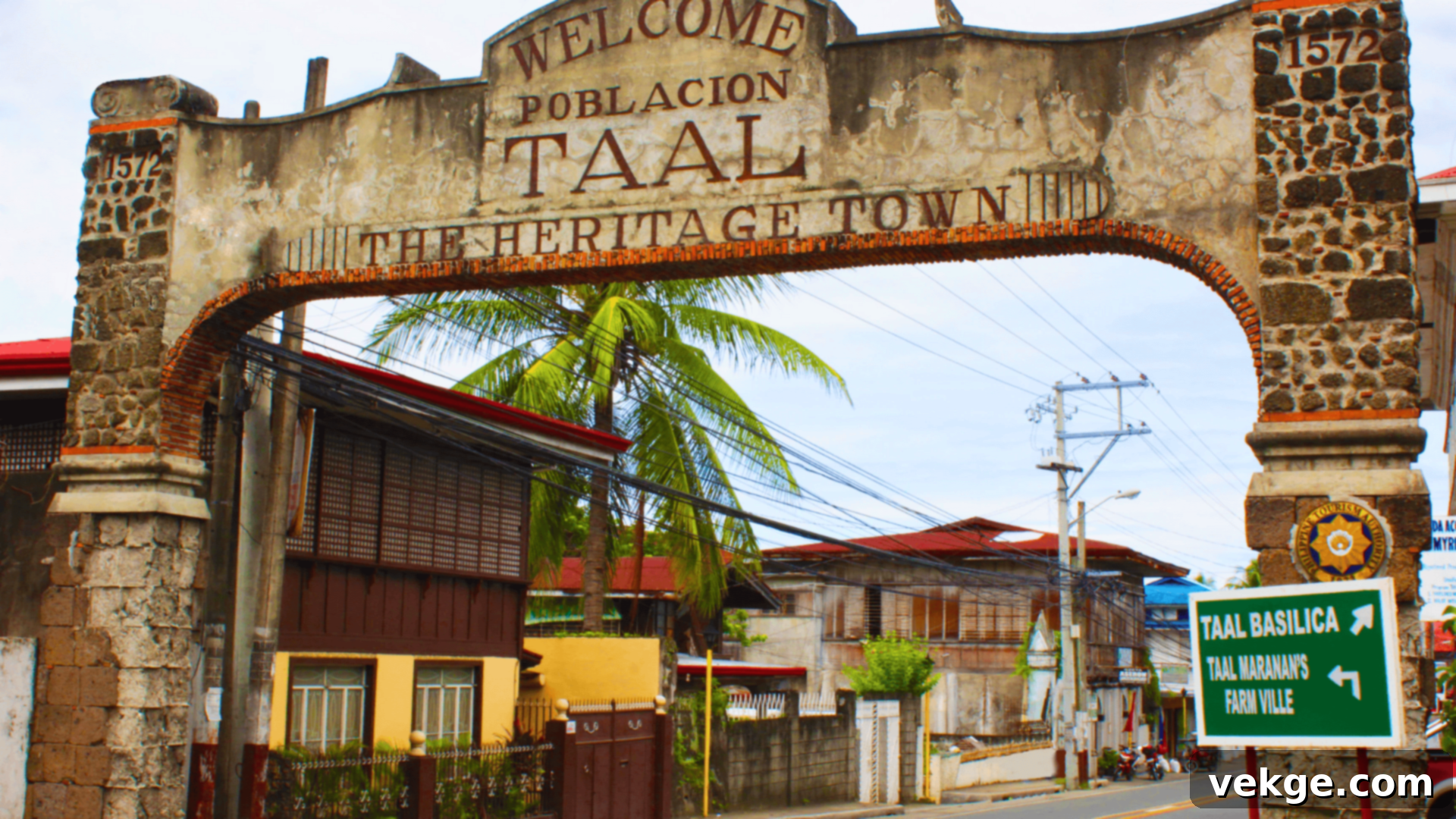
Distinct from Taal Volcano, Taal Heritage Town in Batangas is another captivating journey into the past. This charming town is celebrated for its remarkably well-preserved Spanish-era houses, imposing churches, and significant historical landmarks, earning it the moniker “Heritage Town of Batangas.” It boasts the largest Catholic church in Asia, the Basilica of St. Martin de Tours, and several ancestral homes converted into museums, offering a detailed glimpse into the opulent lifestyles and architectural styles of the colonial period. Walking through its streets, you’ll discover a rich tapestry of history and culture, palpable in every corner. Taal Heritage Town provides an authentic and immersive experience of the Philippines’ enduring colonial legacy.
- Best Times to Visit: For a comfortable and enjoyable trip, the best time to visit is during the dry season, from December to May.
- Visiting Hours: The town is open year-round, with its various attractions typically operating from 8:00 AM to 6:00 PM.
14. Pagsanjan Falls, Laguna
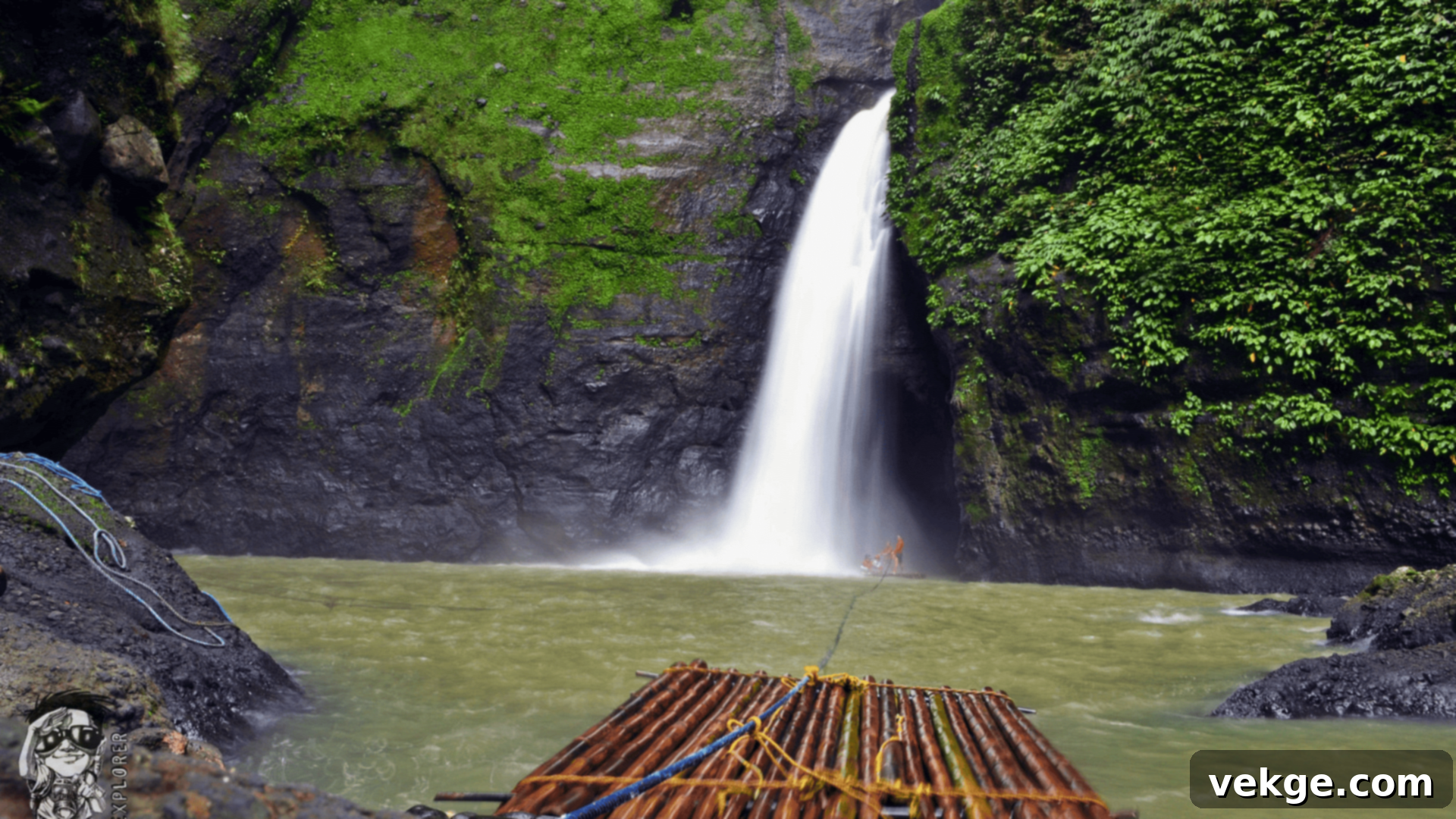
Pagsanjan Falls, located in the lush province of Laguna, is one of the most famous and accessible waterfalls in the Philippines, renowned for its dramatic beauty and the thrilling adventure it offers. The highlight of a visit is the iconic “shooting the rapids” boat ride, where skilled boatmen expertly navigate through the Pagsanjan River’s currents, past towering cliffs and verdant foliage, to reach the main falls. At the falls, visitors can ride a raft directly under the cascade, experiencing the powerful rush of water. This exhilarating journey combines stunning natural scenery with an unforgettable adventure, making Pagsanjan Falls a popular destination for both nature lovers and thrill-seekers.
- Best Times to Visit: The best time to visit is from December to February, during the cooler and drier months, ensuring comfortable boat rides and clearer waters.
- Visiting Hours: Boat rides and access to the falls are available daily, typically from 7:00 AM to 4:00 PM.
15. Rizal Shrine, Calamba
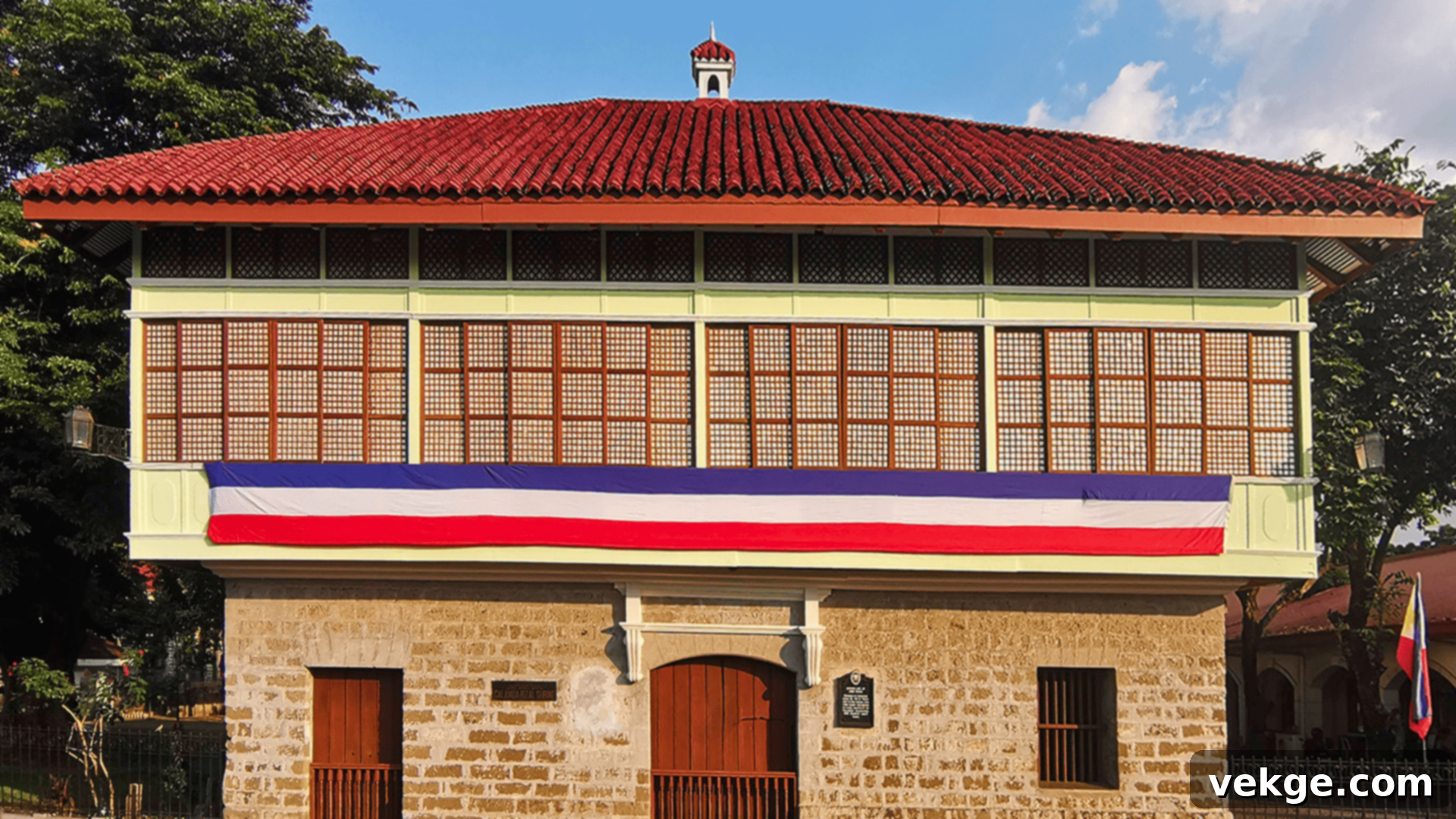
Another significant site dedicated to the Philippines’ national hero, Dr. Jose Rizal, the Rizal Shrine is located in his birthplace, Calamba, Laguna. This well-maintained ancestral house is a meticulously reconstructed version of his childhood home, offering a deeply personal insight into the formative years of the man who would become the nation’s most revered figure. The site includes a museum housing various memorabilia, documents, and artifacts that vividly highlight Rizal’s life, his intellectual pursuits, his family, and his profound impact on Philippine society. Visiting the Rizal Shrine is an essential pilgrimage for anyone seeking to understand the roots of Filipino nationalism and the legacy of Dr. Jose Rizal.
- Best Times to Visit: The cooler months, from December to February, offer more comfortable weather for exploring the shrine and its grounds.
- Visiting Hours: The shrine is generally open daily from 8:00 AM to 5:00 PM, with specific museum hours.
16. Mount Apo, Mindanao
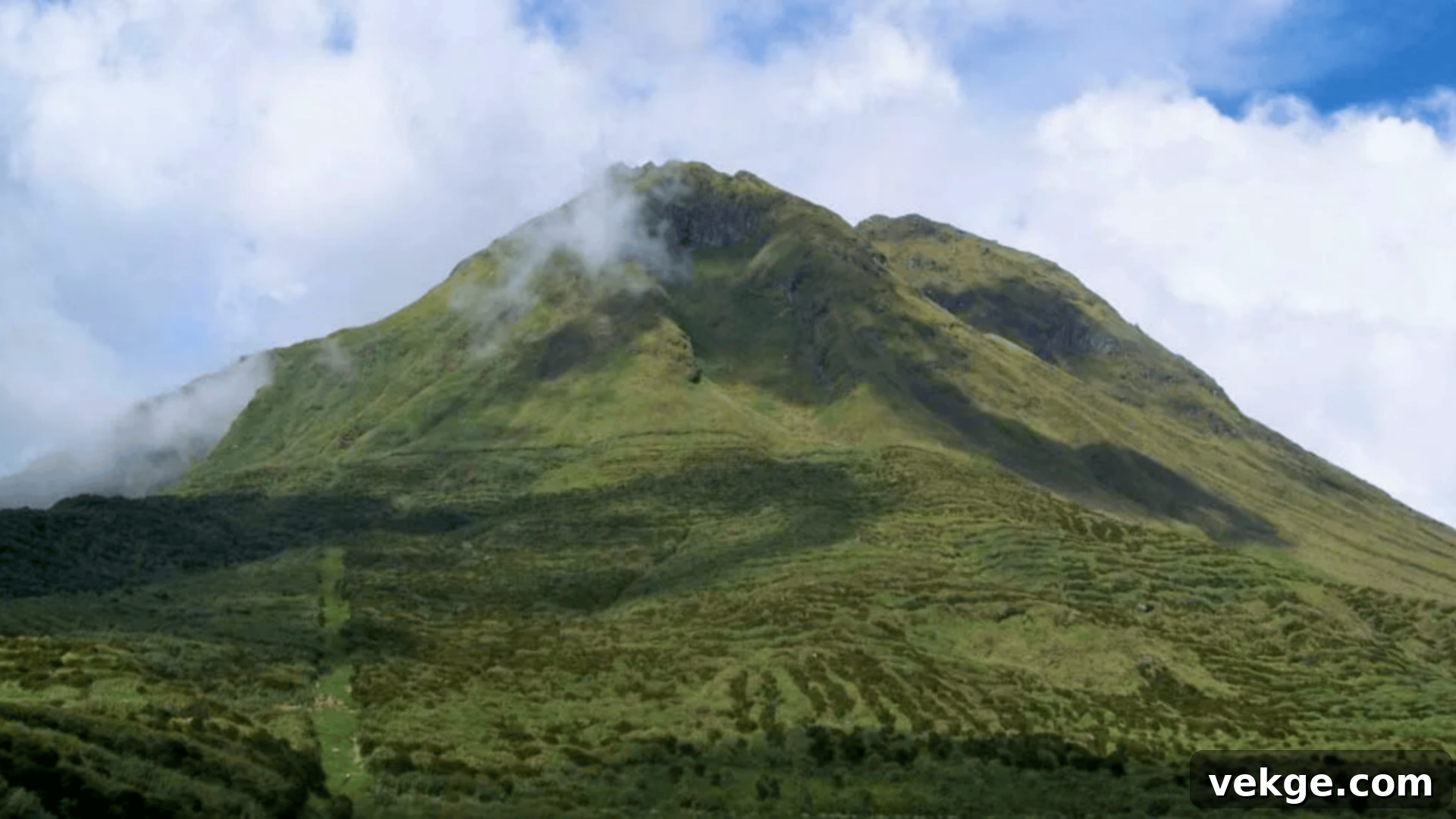
Towering majestically in Mindanao, Mount Apo is the highest peak in the Philippines, reaching an elevation of 2,954 meters above sea level. This active stratovolcano is not only a challenging climb for experienced mountaineers but also a popular destination for hikers and nature enthusiasts seeking unparalleled adventure and breathtaking views. Its diverse ecosystems are home to a rich array of flora and fauna, including the critically endangered Philippine Eagle, the country’s national bird. Trekking Mount Apo offers a chance to scout through lush forests, encounter unique wildlife, and witness stunning sunrises from its summit. It’s a natural landmark that truly embodies the wild and untamed beauty of the Philippines.
- Best Times to Visit: The best time for hiking is during the dry season, from March to May, when the weather conditions are most ideal and trails are less muddy.
- Visiting Hours: The mountain is open year-round for trekking, though permits are required, and most guided expeditions start early, around 6:00 AM.
17. Bohol Bee Farm, Panglao Island

Located on the picturesque Panglao Island in Bohol, the Bohol Bee Farm offers a delightful and unique experience that goes beyond typical tourist attractions. It’s an organic farm dedicated to sustainable living, where visitors can learn about the fascinating world of bees, organic farming practices, and how they contribute to the local ecosystem. Beyond its educational aspect, the farm features a relaxing atmosphere with stunning scenic views of the ocean, a highly-regarded restaurant serving organic and healthy meals (including famous flower salads and honey-glazed chicken), and a shop selling local organic products. It’s a perfect spot to unwind, enjoy delicious food, and appreciate nature’s simple wonders.
- Best Times to Visit: For pleasant weather that enhances the farm’s serene ambiance, the best time to visit is during the dry season, from December to May.
- Visiting Hours: The farm, including its restaurant and shop, is typically open daily from 8:00 AM to 5:00 PM.
18. Cebu Taoist Temple, Cebu City
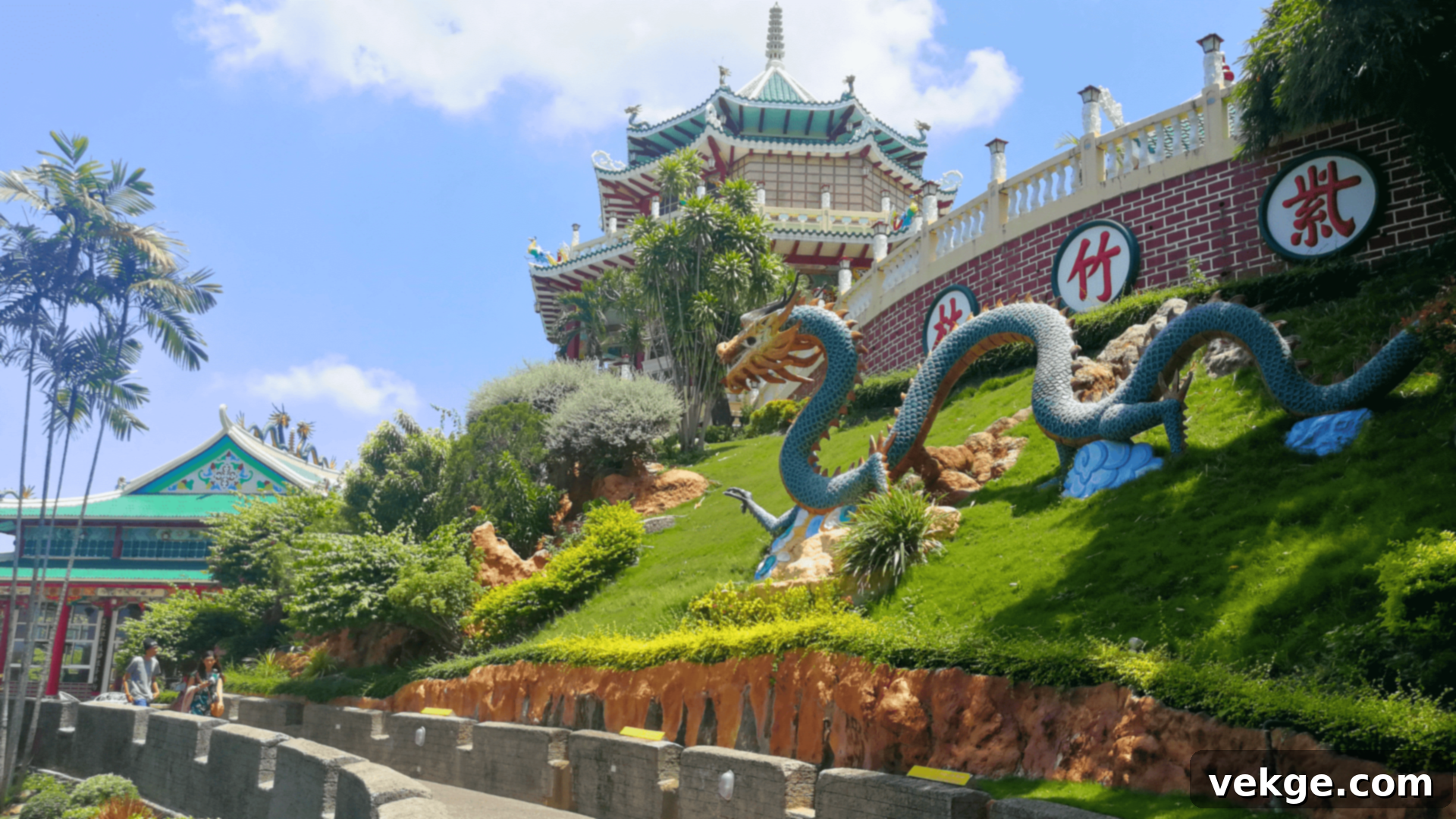
Perched majestically in the hills of Beverly Hills Subdivision in Cebu City, the Cebu Taoist Temple is a beautiful, peaceful, and visually striking place of worship. Built in 1972 by Cebu’s Chinese community, the temple is an architectural marvel, featuring vibrant colors, intricate dragon designs, and pagoda-style roofs. It offers visitors not only a glimpse into Taoist traditions and rituals but also a breathtaking panoramic view of Cebu City. The serene atmosphere, coupled with the detailed craftsmanship and the expansive cityscapes, makes it a unique cultural and spiritual landmark. Visitors are welcome to observe the rituals (respectfully) and enjoy the tranquil surroundings.
- Best Times to Visit: Visit during the cooler months, from November to February, to comfortably enjoy the temple’s outdoor areas and scenic views.
- Visiting Hours: The temple is open daily from 8:00 AM to 5:00 PM.
19. Panglao Island, Bohol
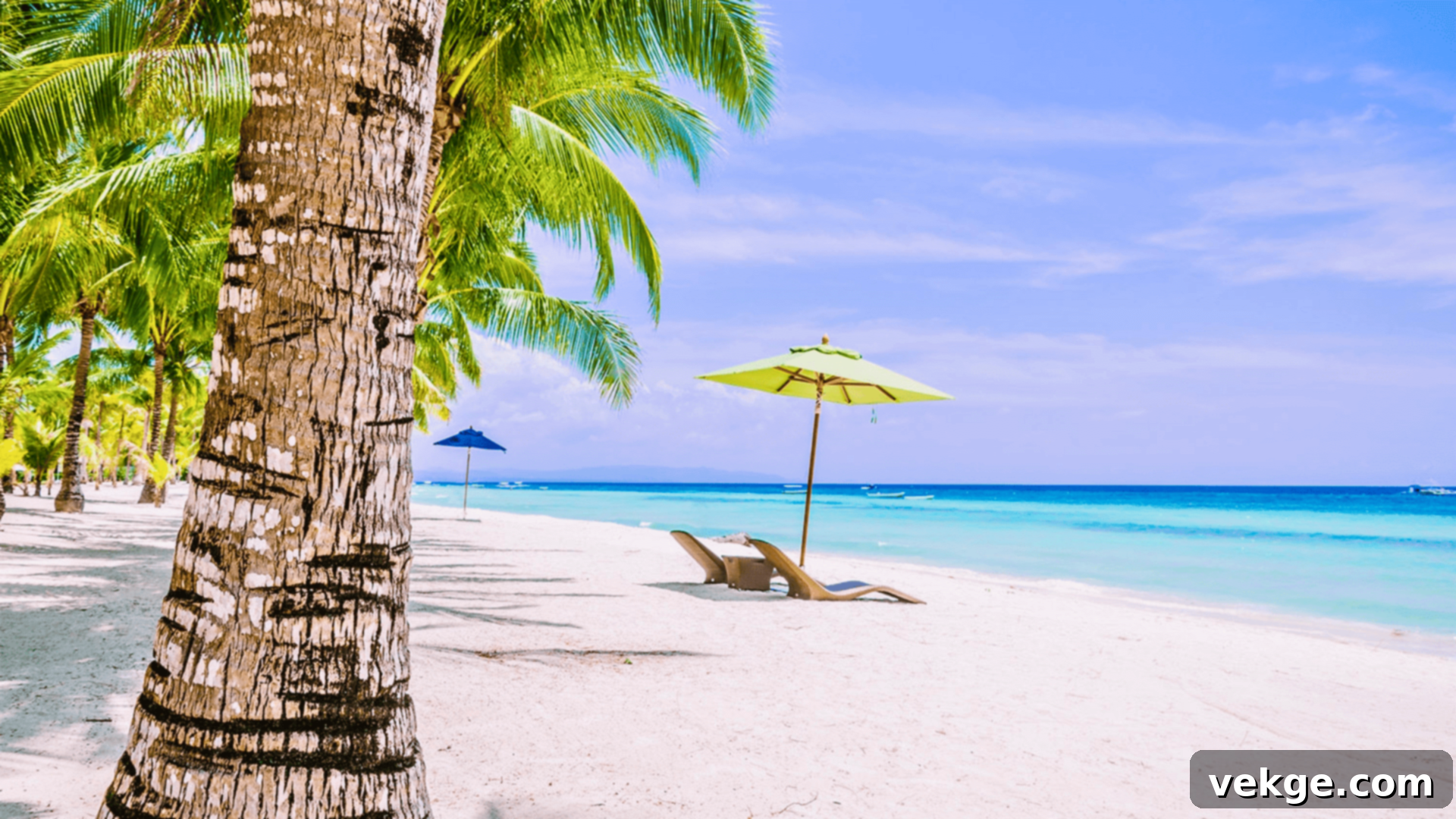
A gem in the heart of the Visayas, Panglao Island in Bohol is renowned for its idyllic white sand beaches, most notably Alona Beach, and its exceptionally crystal-clear waters. It’s a vibrant hub for marine life, making it a world-class destination for diving and snorkeling, attracting enthusiasts from all corners of the globe. The island offers a perfect blend of relaxation and adventure, with opportunities for island hopping, dolphin watching, and exploring diverse coral reefs. Whether you’re seeking a serene spot to unwind by the beach, an underwater exploration, or a lively evening scene, Panglao Island delivers a quintessential tropical paradise experience.
- Best Times to Visit: The best time to visit is during the dry season, from December to May, when the weather is sunny, skies are clear, and sea conditions are ideal for water activities.
- Visiting Hours: The island is accessible year-round, with beaches and establishments typically open during daylight hours and into the evening.
20. Hinagdanan Cave, Panglao, Bohol
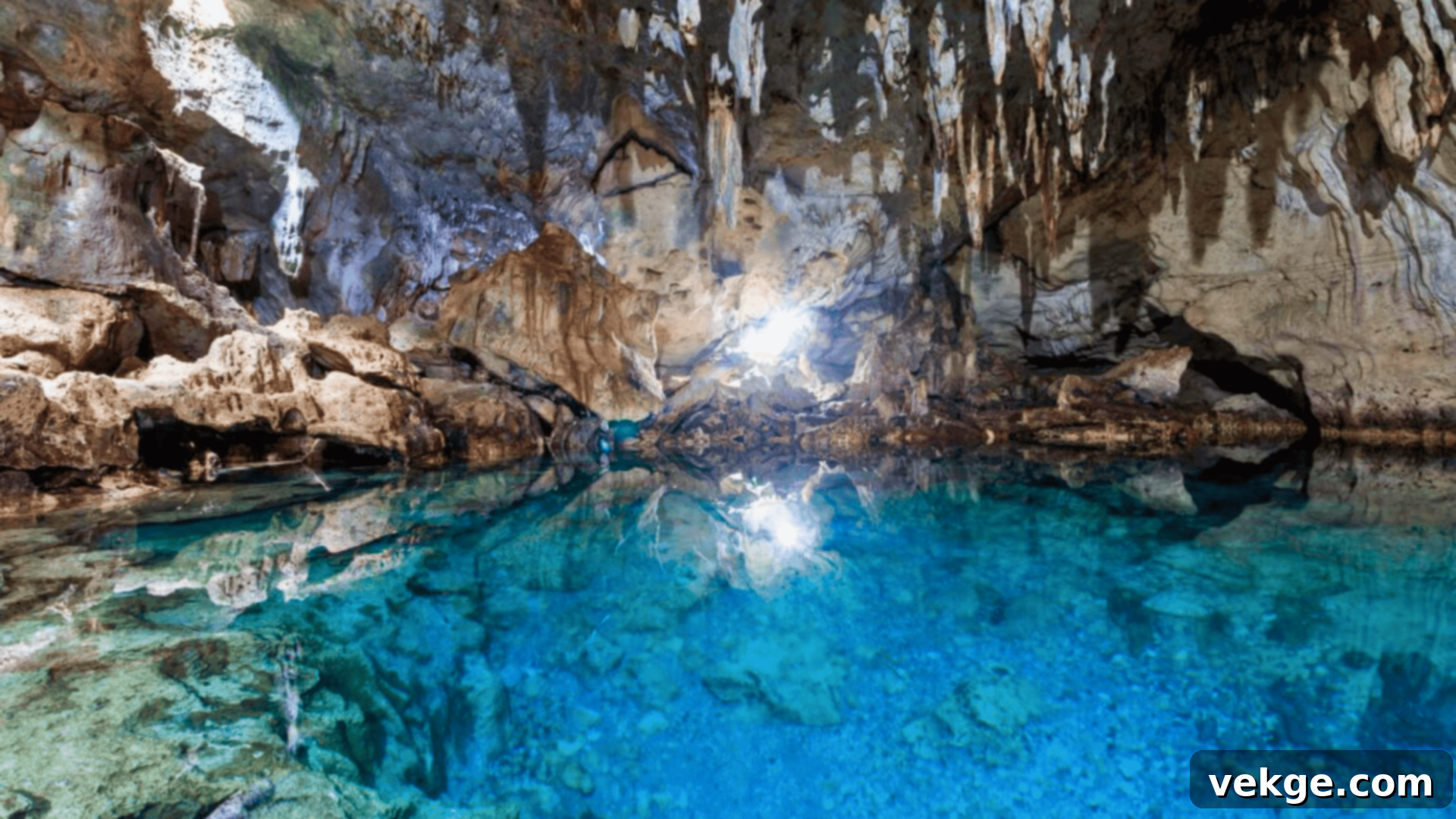
Deep within Panglao, Bohol, lies the enchanting Hinagdanan Cave, a naturally lit limestone cavern featuring a deep, clear lagoon perfect for a refreshing swim. The name “Hinagdanan” translates to “laddered” in local dialect, referring to the steps leading down into the cave. Discovered by a farmer who noticed openings in the ground, this cave is a marvel of natural beauty, with impressive stalactites and stalagmites formed over centuries. The opening above allows natural light to filter in, illuminating the pristine turquoise waters below. It’s a fantastic place to cool off from the tropical heat and marvel at the geological formations, offering a unique underground adventure.
- Best Times to Visit: The best time to visit is from December to April, during the dry season, when the access roads are easily navigable, and the weather is pleasant.
- Visiting Hours: The cave is typically open daily from 8:00 AM to 6:00 PM.
21. National Museum of the Philippines, Manila
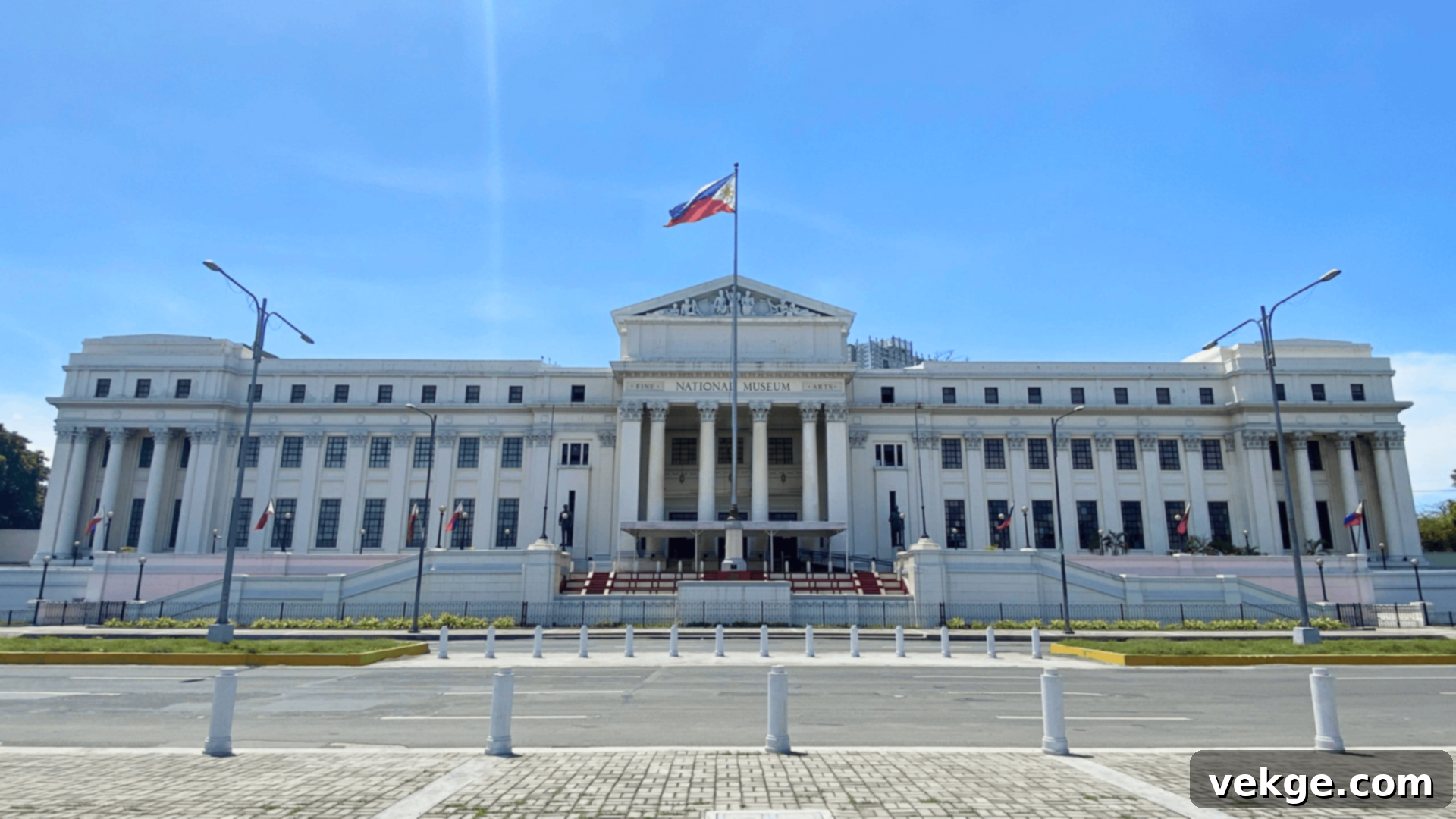
The National Museum of the Philippines, located in Manila, is an essential institution for anyone looking to gain a deeper understanding of the country’s rich heritage, art, and natural history. Comprising several distinct museums—including the National Museum of Fine Arts, National Museum of Anthropology, and National Museum of Natural History—it collectively houses a vast array of exhibits on Philippine art, culture, history, and natural sciences. From priceless archaeological finds like the Manunggul Jar to masterpieces by renowned Filipino artists like Juan Luna’s “Spoliarium,” the museum offers a comprehensive narrative of the Filipino identity. It’s a crucial cultural landmark, providing educational insights and fostering national pride.
- Best Times to Visit: The best time to visit is during weekdays to avoid the larger crowds typically present on weekends, allowing for a more focused and leisurely exploration.
- Visiting Hours: The museums are generally open Tuesday to Sunday, from 10:00 AM to 5:00 PM (closed on Mondays and public holidays).
22. Sunset Boulevard, Roxas City
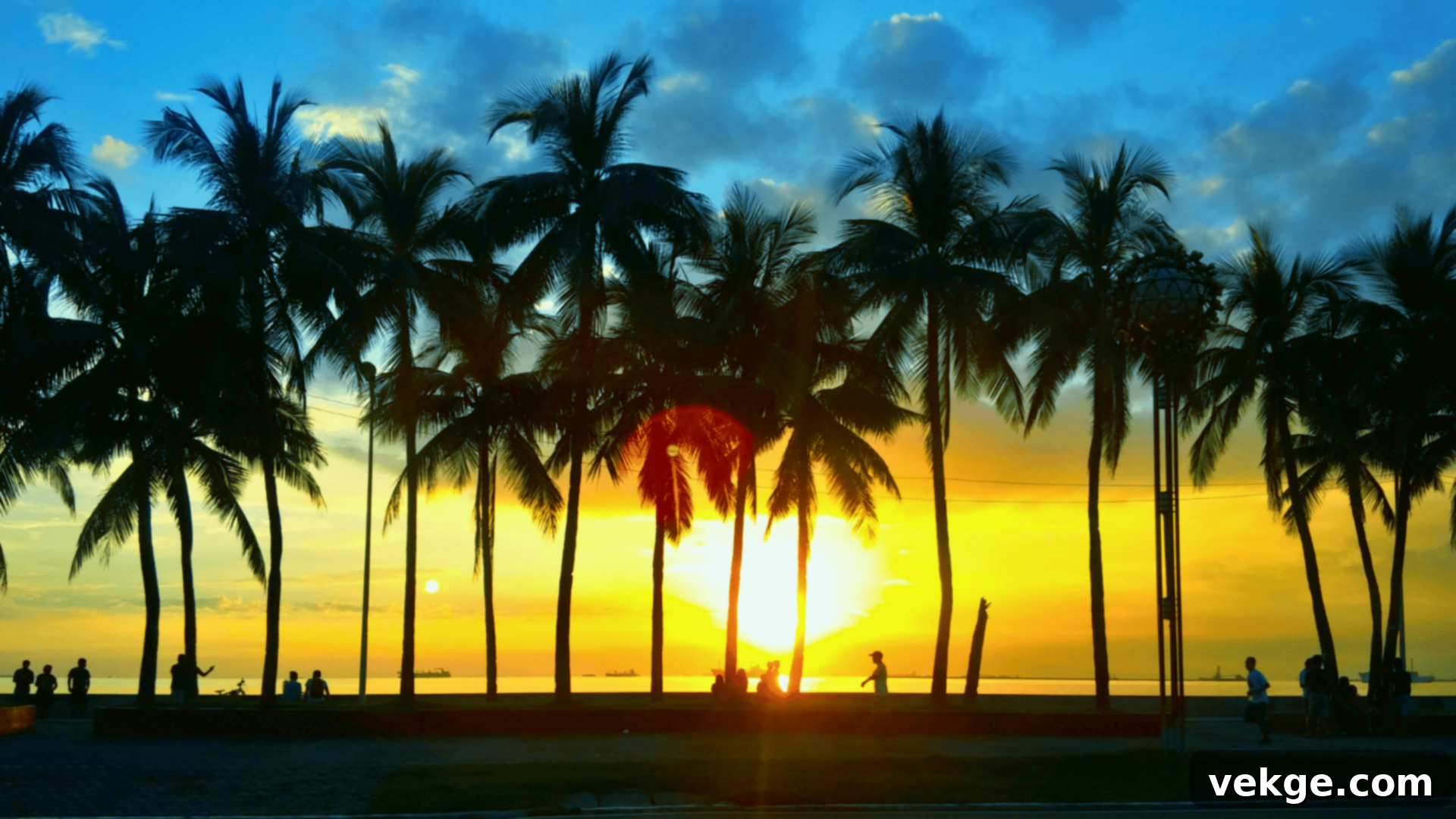
Sunset Boulevard in Roxas City, Capiz, is a picturesque coastal strip that offers an exceptionally serene and beautiful experience. It’s a favorite spot for locals and tourists alike, primarily for its breathtaking views of the ocean and, as its name suggests, its spectacular sunsets. The boulevard provides a tranquil atmosphere, perfect for an evening stroll, a leisurely jog, or simply sitting and enjoying the sea breeze. With its calm ambiance and stunning natural vistas, it’s an ideal place to unwind after a day of exploration, offering a moment of peace and natural beauty that captures the essence of coastal Philippine charm. It’s a simple yet profoundly rewarding landmark for relaxation and reflection.
- Best Times to Visit: For the most beautiful view, visit in the late afternoon, just before sunset, to witness the sky ablaze with vibrant colors.
- Visiting Hours: The boulevard is open year-round, with the best visiting hours for sunset viewing from 4:00 PM until after the sun dips below the horizon.
Conclusion: Your Philippine Adventure Awaits
The Philippines is undoubtedly a country brimming with awe-inspiring landmarks, each one a unique testament to its rich tapestry of natural beauty, profound history, and vibrant culture. From the ancient, human-made wonders of the Banaue Rice Terraces to the majestic, naturally sculpted Chocolate Hills, and from the solemn, history-laden walls of Intramuros to the pristine, underwater paradises of Palawan, these places collectively tell a compelling story of resilience, faith, and the extraordinary spirit of the Filipino people.
We sincerely hope this extensive guide has provided you with valuable insights and sparked your imagination, whether you’re meticulously planning your next adventure or simply curious to learn more about this enchanting nation. The diversity of experiences, from thrilling volcanic hikes to peaceful historical walks, ensures that every traveler will find something to cherish.
With careful planning and an open heart, your journey through the Philippines promises to be an unforgettable one, filled with rich historical narratives, breathtaking scenic views, and unique cultural encounters that will leave a lasting impression. Keep exploring, keep dreaming, and come discover for yourself what makes the Philippines truly special and a must-visit destination on your global travel list!
Are you ready to visit these incredible landmarks or delve even deeper into their fascinating histories? Please feel free to share your thoughts, favorite Philippine landmarks, or memorable experiences in the comments section below. We’d love to hear from you!
